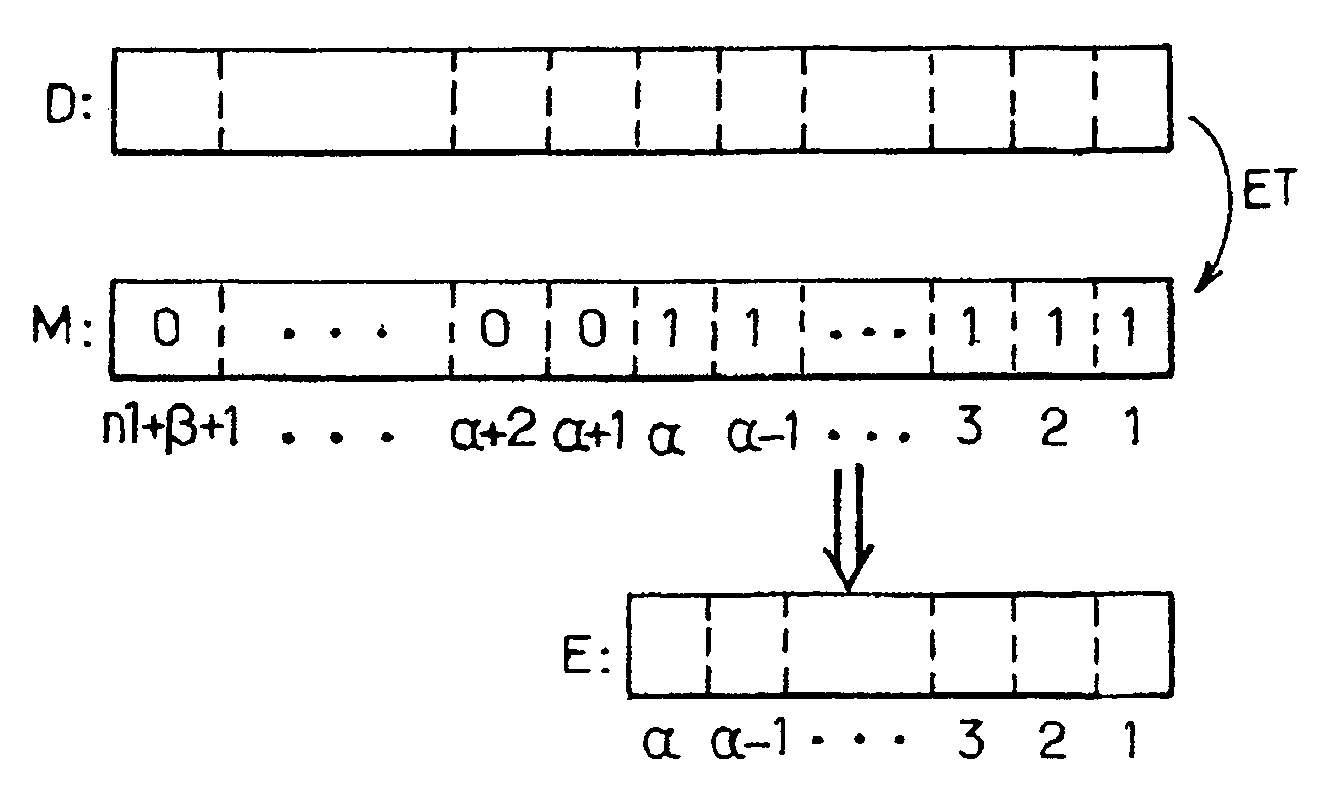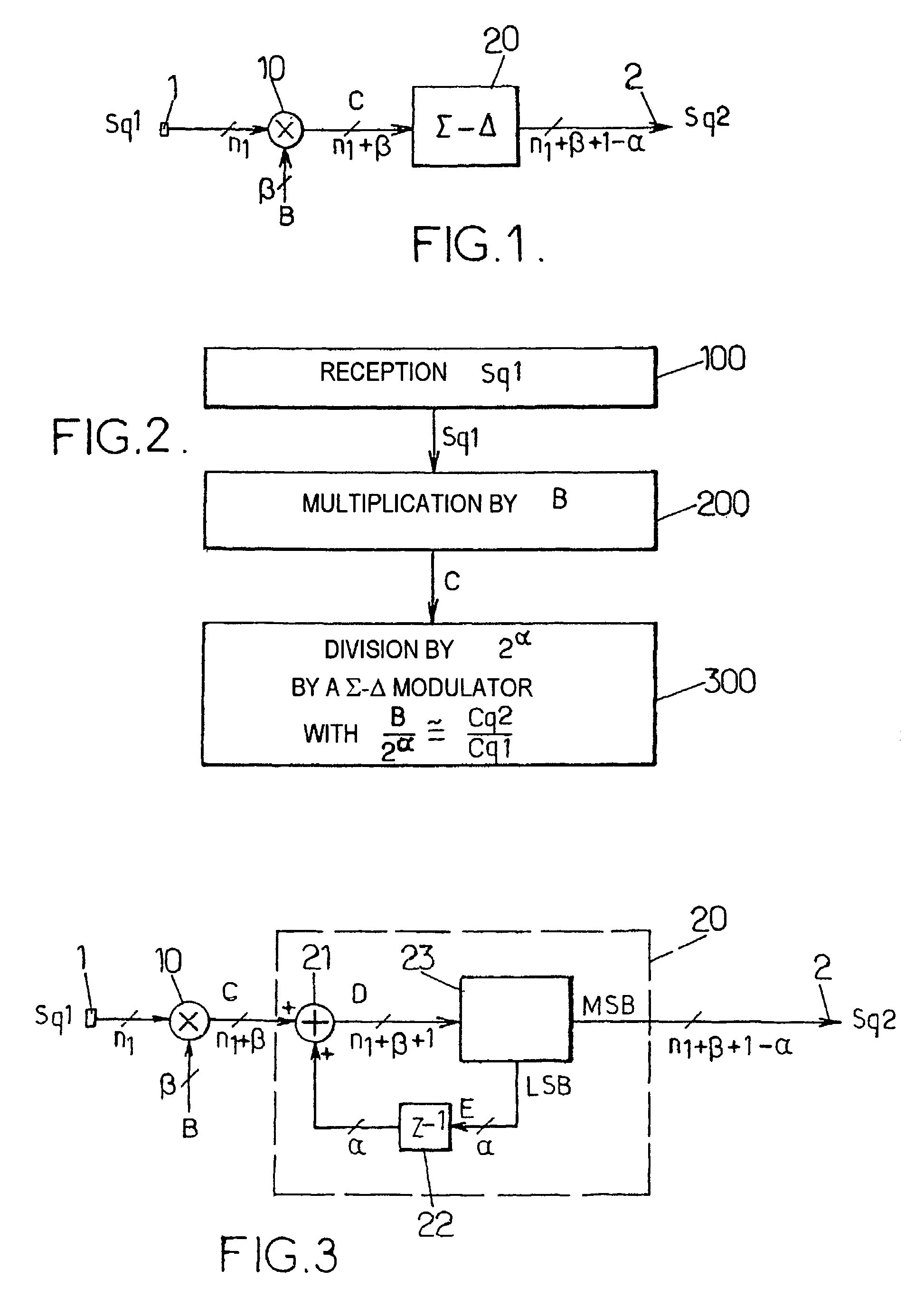Method and device for converting a quantized digital value
- Summary
- Abstract
- Description
- Claims
- Application Information
AI Technical Summary
Benefits of technology
Problems solved by technology
Method used
Image
Examples
first embodiment
[0085]The diagram in FIG. 3 illustrates a device according to the invention, which is suitable for carrying out a first variant of the method.
[0086]In this first embodiment, the sigma-delta modulator 20 comprises means 21 such as a digital adder, which receive as input the first intermediate digital value C as a first operand, on the one hand, and a digital error value E as a second operand, on the other hand. The latter is encoded over at most α bits. The means 21 deliver as output a second intermediate digital value D encoded over at most n1+β+1 bits.
[0087]The device further comprises selection means 23, such as a digital discriminator, for selecting the n2 most significant bits of the second intermediate digital value D as the digital output value Sq2, and for selecting the α least significant bits of said second intermediate digital value D as the digital error value E. It follows that n2 is equal to n1+β+1−α. The means 23 receive the value D as input and deliver the value Sq2 a...
second embodiment
[0089]The diagram in FIG. 4 illustrates a device according to the invention, which is suitable for carrying out a second variant of the method.
[0090]In this second embodiment, the selection means 23 of the device comprise an operator 24 for shifting to the right by α bits. Such an operator is formed, for example, with the aid of a properly controlled shift register. This operator 24 receives as input the n1+β+1 bits of the second intermediate digital value D. It delivers as output the n1+β+1−α most significant bits of the second intermediate digital value D as a digital output value Sq2.
[0091]The selection means 23 furthermore comprise means 25 for applying a mask to the second intermediate digital value D.
[0092]Such a mask is represented in FIG. 5 with the reference M. It is a digital value stored in an appropriate register and having at most n1+β+1 bits, the n1+β+1−α most significant bits of which are equal to the logical value 0 and the α least significant bits of which are equal...
third embodiment
[0094]The diagram in FIG. 6 illustrates a device according to the invention, which is suitable for carrying out a third variant of the method.
[0095]In this third embodiment, the selection means 23 of the device still comprise an operator 24 for shifting to the right by α bits, which has the same function as the operator 24 of the device in FIG. 4.
[0096]The selection means 23 further comprise an operator 26 for shifting to the left by α bits, which receives as input the n1+β+1−α bits of the digital output value Sq2 and delivers as output a third intermediate digital value F, encoded over at most n1+β+1 bits. The operator 26 is, for example, a properly controlled shift register. They furthermore comprise an operator 27 for taking the difference between the intermediate digital values F and C. The operator 27 is, for example, a digital subtracter. It receives the third intermediate digital value F as a first operand, and the first intermediate digital value C as a second operand. It de...
PUM
 Login to View More
Login to View More Abstract
Description
Claims
Application Information
 Login to View More
Login to View More - R&D
- Intellectual Property
- Life Sciences
- Materials
- Tech Scout
- Unparalleled Data Quality
- Higher Quality Content
- 60% Fewer Hallucinations
Browse by: Latest US Patents, China's latest patents, Technical Efficacy Thesaurus, Application Domain, Technology Topic, Popular Technical Reports.
© 2025 PatSnap. All rights reserved.Legal|Privacy policy|Modern Slavery Act Transparency Statement|Sitemap|About US| Contact US: help@patsnap.com



